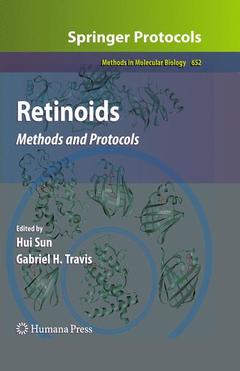Description
Retinoids, 2010
Methods and Protocols
Methods in Molecular Biology Series, Vol. 652
Coordinators: Sun Hui, Travis Gabriel H.
Language: English
Subjects for Retinoids:
Keywords
Transport; Vitamin; Vivo; biological functions; cells; enzymes; hybridization; molecular biology; tissue
Retinoids
Publication date: 09-2012
350 p. · 17.8x25.4 cm · Paperback
Publication date: 09-2012
350 p. · 17.8x25.4 cm · Paperback
Retinoids: methods and protocols
Publication date: 06-2010
350 p. · 17.8x25.4 cm · Hardback
Publication date: 06-2010
350 p. · 17.8x25.4 cm · Hardback
Description
/li>Contents
/li>Comment
/li>
New and exciting biological functions are still being discovered for vitamin A derivatives, including the vast number of physiological activities of retinoids. In Retinoids: Methods and Protocols, expert researchers in the field present the most recent technical tools with diverse techniques for both in vitro and in vivo studies. Combining biochemical, biophysical, and cell biological techniques, the book addresses topics such as the detection and quantitation of retinoids using HPLC, mass spectrometry, and fluorescence, fluorescence anisotropy of retinol binding protein, cell culture models for studying retinoid transport and the role of retinol in embryonic stem cell culture, as well as many other detailed procedures. Written in the highly successful Methods in Molecular Biology? series format, chapters include introductions to their respective subjects, lists of the necessary materials and reagents, step-by-step, readily reproducible laboratory protocols, and notes highlighting tips on troubleshooting and avoiding known pitfalls. Authoritative and cutting-edge, Retinoids: Methods and Protocols seeks to aid beginning and experienced researchers from widely varied fields in the search to uncover even more vital aspects of vitamin A?s impact on the human body.
Quantification of Endogenous Retinoids.- Culture of Highly Differentiated Human Retinal Pigment Epithelium for Analysis of the Polarized Uptake, Processing, and Secretion of Retinoids.- Feeder-Independent Culture of Mouse Embryonic Stem Cells Using Vitamin A/Retinol.- In Vitro Assays of Rod and Cone Opsin Activity: Retinoid Analogs as Agonists and Inverse Agonists.- Physiological Studies of the Interaction Between Opsin and Chromophore in Rod and Cone Visual Pigments.- Measurement of the Mobility of All-Trans-Retinol with Two-Photon Fluorescence Recovery After Photobleaching.- Microfluorometric Measurement of the Formation of All-Trans-Retinol in the Outer Segments of Single Isolated Vertebrate Photoreceptors.- HPLC?/?MSN Analysis of Retinoids.- Binding of Retinoids to ABCA4, the Photoreceptor ABC Transporter Associated with Stargardt Macular Degeneration.- Fluorescence-Based Technique for Analyzing Retinoic Acid.- The Interaction Between Retinol-Binding Protein and Transthyretin Analyzed by Fluorescence Anisotropy.- Assay of Retinol-Binding Protein–Transthyretin Interaction and Techniques to Identify Competing Ligands.- Molecular Biology and Analytical Chemistry Methods Used to Probe the Retinoid Cycle.- Visualization of Retinoid Storage and Trafficking by Two-Photon Microscopy.- Reverse-Phase High-Performance Liquid Chromatography (HPLC) Analysis of Retinol and Retinyl Esters in Mouse Serum and Tissues.- Detection of Retinoic Acid Catabolism with Reporter Systems and by In Situ Hybridization for CYP26 Enzymes.- Diet in Vitamin A Research.- Experimental Approaches to the Study of A2E, a Bisretinoid Lipofuscin Chromophore of Retinal Pigment Epithelium.- Analysis of the Retinoid Isomerase Activities in the Retinal Pigment Epithelium and Retina.- Techniques to StudySpecific Cell-Surface Receptor-Mediated Cellular Vitamin A Uptake.
Comprehensive technical guides to roles of vitamin A and retinoids in diverse physiological and pathological states and molecular pathways Up-to-date descriptions of biochemical, biophysical, and cell biological techniques Easily accessible reference volume for beginners and experts Includes supplementary material: sn.pub/extras
© 2024 LAVOISIER S.A.S.
These books may interest you

Retinoid Signaling Pathways 166.19 €



